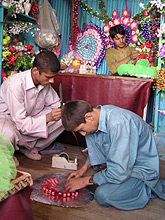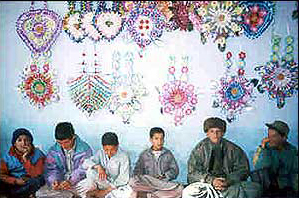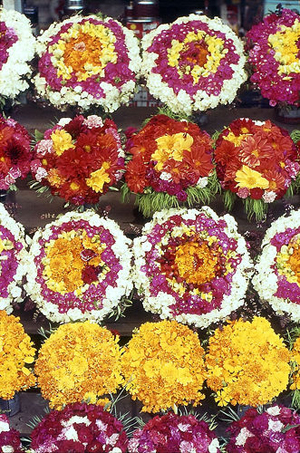Human Flower Project
Sunday, December 02, 2007
Afghan Flowers—Living Embroidery
Did silk stitching inspire the floral aesthetics of Afghanistan?
 Boys working at the Gul-e-Maryam flower shop, Kabul
Boys working at the Gul-e-Maryam flower shop, Kabul
Photo: ICRC
When you think you’ve seen it all, whoosh! Here comes something gorgeous and completely new—to our American eyes, anyway: the floristry of Afghanistan.
European flower arrangements (which still prevail in the U.S., too) seem to us to be descendents of 17th century science and baroque art. As early botanists were collecting and classifying plant discoveries from the colonies, European floral designers delighted in lush varieties of color and shape; “Let’s make a bouquet of every flower known to humankind,” appears to be the guiding principle. And the results are lavish. In contrast, Japanese floral design is the child not of science but philosophy. It balances a few asymmetrical elements, bringing into focus not abundance or color but line.
 Afghan boys with floral decorations
Afghan boys with floral decorations
made to sell for the Eid
Photo: Rabia via BBC
But from the little we’ve seen, the flowers of Afghanistan have another aesthetic all their own. These designs seem to have been borrowed from the region’s textile heritage, silk, cotton, and wool stitching on fabric. The overriding effect is neither line nor color, but pattern. It’s electric, like these splendid dress panels vibrating with embroidery. In Afghanistan, embellishments adorn men’s and women’s clothing—fancy table linens, too. And check out this bicycle seat!
We’ve found a few photographs of Afghan flower designers (many of them boys) piecing together these marvelous ornaments of blossoms. Many of the arrangements actually seem to be handled as wall decorations, just as a beautiful embroidered textile would be.
 Turban-like bouquets, for sale in Kabul, 1972
Turban-like bouquets, for sale in Kabul, 1972
Photo: Ard Hesselink
The most stunning images we’ve seen are pictures that Ard Hesselink of Alkmaar, the Netherlands, took in Kabul in 1972 when, as he writes, “there was still a king in Afghanistan.” These arrangements, with their concentric designs of purples and golds, certainly seem fit for royalty—though their shapes are reminiscent of turbans.
We have only scratched the surface on this subject and hope to learn lots more from those living in Afghanistan or visiting. Please tell us the names of those gorgeous wall pieces. Do women and older men work with flowers, too, or is the florist trade for some reason considered young men’s work? Do the names of floral designs and decorations bear out a relationship to regional embroidery traditions, as we’ve surmised?
And with all that’s happened in the past three decades, do flowers in Afghanistan today look anything like Ard’s picture from the early 1970s? Can an aesthetic this original and strong survive thirty years of war?




